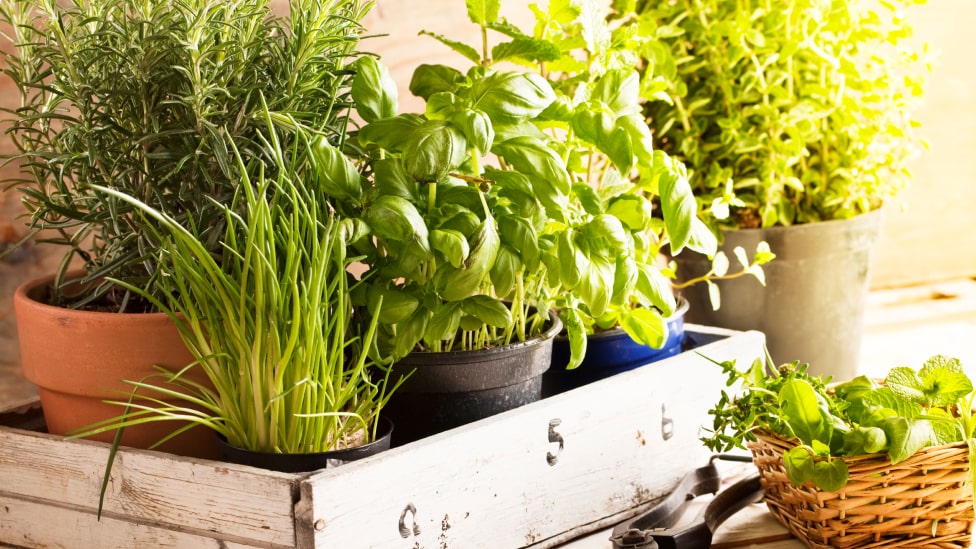Beginner’s guide to growing herbs
Fresh herbs are a must for any keen cook. Legendary chef Stephanie Alexander explains how to grow your own and offers her top tips on how to use them.

Grow your herbs near your kitchen so they are easily accessed.
Where should I grow my herbs?
Herbs near the kitchen are great as they are easily accessible, and you can use them readily. Most herbs and vegetables need between six and eight hours of sun per day, although some herbs will be OK with a bit less.
Any tips on soil preparation?
Healthy soil can be created with organic compost, manures, and mulch. You should be able to easily slide your garden fork into the soil at least 15cm deep. If you are growing in containers, 30cm deep is enough for most plants. Good to remember that woody herbs such as rosemary and thyme traditionally grow without attention on exposed hillsides in Europe, so they are not too fussy.
Pots or a garden bed – does it matter?
Whatever you have room for! Remember to give mint its own pot so it does not take over. Some others will happily co-exist.
What are the basic essential herbs for a kitchen garden?
Every garden – and kitchen – needs the basics: parsley, thyme and rosemary. If you’re a novice, you can’t go wrong with thyme, oregano, parsley, rosemary and sage. I consider sage an essential as I absolutely love crisped sage leaves in brown butter and it has such pretty flowers and is loved by the bees. And don’t forget French tarragon, such a lovely herb with a faint taste of aniseed. If you’re excited by Asian cooking, try Thai basil, coriander and Vietnamese mint. Dill is important in preparing many pickles.
Does the placement of herbs matter?
Annual herbs such as dill, basil and coriander are fine mixed with favourites such as parsley. Tarragon disappears completely in the cold months so it needs a clear marker to show where it is, so its root system is not accidentally dug up. Pay attention to how big your herbs will grow – rosemary, for instance, can grow into a very large shrub, but there are varieties of rosemary that have softer leaves and grow quite low to the ground.
Any tips on how to maintain my herb garden?
Woody herbs such as rosemary, thyme and sage benefit from an annual prune. Having a consistent watering regimen ensures consistent growth, but don’t over-water them. Most herbs do not like having wet feet so the plot or pot needs to be well-drained.
To extend production, basil needs regular picking of the shoots, while parsley, dill and coriander should be picked stem-by-stem from the outside of the plant.
Allow some of your parsley to go to seed to produce more parsley for the next year. If you have an abundance of tarragon make a quantity of tarragon vinegar using a good-quality white wine vinegar. If you want to have oregano for the winter pick long sprigs just after flowering and bundle them and dry them in your kitchen, away from greasy fumes.
Stephanie’s quick tips with fresh herbs
- Mix parsley with tarragon and chives and sprinkle over seasoned fish fillets that you then bake in the oven in a parcel of buttered baking paper.
- Basil is best of all with chunked or sliced ripe tomatoes, extra virgin olive oil and a little sea salt. This classic salad becomes a substantial lunch if you add a ball of fresh mozzarella and a slice of crusty bread to mop up the juices.
- Cook sage leaves in a small pan with chunks of cold butter and swirl the pan until the butter sizzles and smells nutty and the sage leaves are crisp. Spoon over fish, cooked zucchini, pasta, or steamed potatoes.
- Mix plenty of chopped tarragon with softened butter. Add a squeeze of lemon juice, salt and pepper and work a generous quantity of this butter under the breast skin of a chicken before roasting it.
The Stephanie Alexander Kitchen Garden Foundation is in partnership with Coles. For more information about the Kitchen Garden Foundation and how you can get involved visit www.kitchengardenfoundation.org.au.